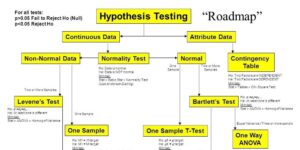
Part Submission Warrant (PSW): Understand How This Document Fits Into PPAP
Published:In today’s competitive business environment, maintaining a high level of quality has become vital to a company’s success. It is imperative that suppliers provide quality parts that meet customer requirements the first time and every time.
Read more
Process Control Plan: A Roadmap to Process Success
Published:In Six Sigma, you will often hear the phrase, “It worked so well we stopped doing it.” The purpose of a process control plan is to maintain the gains of your project and prevent this from happening.
Read more
Understanding Poka-Yoke: Eliminating Defects with Proactive Measures
Updated:What is poka-yoke? Have you ever accidentally microwaved your face? No? You’ve never opened the microwave door while it was cooking and accidentally exposed your face to microwave energy? I know that you haven’t because whenever you open the door, the microwave stops running. There is a switch that triggers when the door is opened […]
Read morePearson’s Correlation
Published:To answer the question of how strong and in what direction is the relationship between two continuous variables you would use the Pearson correlation coefficient (r). Let’s learn more about this statistical descriptor and what it tells you about your data.
Read more
The 10 Best Quality Books of All-Time
Published:Looking for good books to read on the topics of quality, Six Sigma, Lean and OpEx? This reading list shares the best quality-topic books of all-time and book recommendations by topic.
Read more
The History of the Hypothesis Testing Flow Chart
Published:Here’s the story about how the hypothesis testing flow chart was developed in Barcelona in 1995, as told by Mike Carnell.
Read more
Introducing iSixSigma Version 5 ?
Published:After more than six months of hard work, iSixSigma is celebrating its relaunch today and I’m excited to announce the brand new, redesigned iSixSigma.com.
Read more
Z
Published:A Z value is a data point’s position between the mean and another location as measured by the number of standard deviations. Z is a universal measurement because it can be applied to any unit of measure. Z is a measure of process capability and corresponds to the process sigma value that is reported by […]
Read more
Zadj
Published:The probability of a defect when defects are correlated. For example, when linewidths are printed too wide the process can cause thousands of ‘bridging’ defects, so although the number of defects is extremely high, there is only one opportunity. Unless of course there are say four sensitive areas on the circuit so that a slight […]
Read more

Scatterplot
Published:A graph of the points representing a collection of data, is one of the most useful techniques for gaining insight into the relationship between two variables.
Read more
Responsibility
Published:Defined or assumed conditional liability before the fact – limited to overt practices. Capacity to be responsible assumes the use of adequate expertise and capability.
Read more
Reliability
Published:The reliability of an item is the probability that it will adequately perform its specified purpose for a specified period of time under specified environmental conditions. Dr. Lawrence M. Leemis, Department of Mathematics, College of William and Mary, from his textbook titled Reliability: Probabilistic Models and Statistical Methods.
Read more

Random Sample
Published:A data point taken at random from the universe or population of your process.
Read more
Procedures: The Key to Consistency in Business
Updated:There are all kinds of procedures for the many things that people do every single day. Every family household has procedures for basic tasks like putting dishes away, assembling for dinner or getting into the car. Likewise, every place of business has procedures for the essential activities they do on a regular basis. Overview: What […]
Read more
Ishikawa, Ichiro
Updated:Japanese quality professional widely known for the Ishikawa diagram also known as the fishbone or cause and effect diagram. He is also known as Ishikawa, Kaoru.
Read more

Error (Type I)
Published:Error that concludes that someone is guilty, when in fact, they really are not. (Ho true, but I rejected it–concluded Ha). Also known as ALPHA error. Also known as Producer’s risk.
Read more
Error (Type II)
Published:Error that concludes that someone is not guilty, when in fact, they really are. (Ha true, but I concluded Ho). BETA Accept an hypothesis or statement as true when it is false: Ho is false, but I conclude Ho is true. Error that concludes that someone is not guilty, when in fact, he or she […]
Read more
Enhancing Skills and Morale: A Guide to the Gwilliam Motivational Model
Updated:Motivation is a critical factor that drives human behavior, and it plays a vital role in the success of individuals and businesses. The Gwilliam Motivational Model is a psychological theory that explains the factors that motivate individuals to perform at their best. Overview: What is the Gwilliam Motivational Model The Gwilliam Motivational Model is a […]
Read more